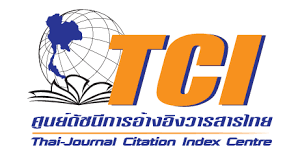ความสุขทางเศรษฐศาสตร์จากการทำงานของบุคลากรสายวิชาการในมหาวิทยาลัย: การประยุกต์ใช้แนวทางการสุ่มซ้ำโดยเครื่องจักรเพื่อลดข้อจำกัดของข้อมูล
คำสำคัญ:
ความสุขทางเศรษฐศาสตร์, บุคลากรสายวิชาการในมหาวิทยาลัย, แนวทางการสุ่มซ้ำโดยเครื่องจักร์บทคัดย่อ
บทความนี้มุ่งสำรวจความสุขทางเศรษฐศาสตร์จากการทำงานของบุคลากรสายวิชาการในมหาวิทยาลัยโดยใช้วิธีการสุ่มซ้ำด้วยเครื่องจักรเพื่อลดข้อจำกัดของข้อมูลเชิงสำรวจ อันจะก่อประโยชน์แก่หน่วยงานต้นสังกัดในการกำกับดูแลความอยู่ดีมีสุขของผู้ปฏิบัติงานได้อย่างถูกต้องตรงจุดและเป็นแนวทางในการวิจัยแก่ผู้ที่เผชิญกับข้อจำกัดของข้อมูล โดยมีกลุ่มตัวอย่างที่ใช้ในการศึกษา คือ บุคลากรสายวิชาการในมหาวิทยาลัย (อาจารย์ประจำ) ทั้งสิ้น 30 ราย สำหรับข้อมูลเชิงสำรวจ ในการศึกษานี้ได้ถูกเก็บรวบรวมโดยใช้แบบสอบถามเป็นเครื่องมือและเข้าถึงกลุ่มตัวอย่างด้วยวิธีการสุ่มแบบอย่างง่ายในพื้นที่กรุงเทพมหานคร อนึ่ง ข้อมูลความสุขทางเศรษฐศาสตร์จากการทำงานจะถูกวิเคราะห์ด้วยแบบจำลองการถดถอยตามวิธีแบบวางนัยทั่วไป (GLMs) ทั้งก่อนและหลังการสุ่มซ้ำ ร่วมกับการประเมินความเอนเอียงเพื่อเปรียบเทียบประสิทธิภาพของแบบจำลอง ผลลัพธ์การศึกษาชี้ให้เห็นว่า ความสุขทางเศรษฐศาสตร์จากการทำงานมาจากการพัฒนาตนเองและผลงาน เป็นหลัก รองลงมาคือสภาพแวดล้อมในการทำงาน ตลอดจนภาระงานและการประเมินผล ซึ่งมีผลต่อความสุขในการทำงานมากกว่าร้อยละ 60 อย่างมีนัยสำคัญทางสถิติ มากไปกว่านั้น ผลลัพธ์จากการสุ่มซ้ำด้วยเครื่องจักรสามารถช่วยลดความเอนเอียงของแบบจำลองได้เมื่อช่วงการสุ่มอยู่ระหว่าง 100 ถึง 1,000 รอบ
เอกสารอ้างอิง
กระทรวงสาธารณสุข. (2565). รายงานอัตราการฆ่าตัวตายของประชากร, สืบค้นเมื่อ 27 ธันวาคม 2566, จาก https://spd.moph.go.th/
จตุพร บุญเหมย. (2563). ผลกระทบจากพระราชบัญญัติคุ้มครองข้อมูลส่วนบุคคล พ.ศ. 2562 ที่มีต่อธุรกิจธนาคารพาณิชย์ในประเทศไทย (การศึกษาค้นคว้าอิสระปริญญาบริหารธุรกิจมหาบัณฑิต). มหาวิทยาลัยธรรมศาสตร์.
เจษฎา คูงามมาก และ พาชิตชนัต ศิริพานิช. (2557). ความเครียดในการทำงานของอาจารย์มหาวิทยาลัยรัฐ. วารสารพัฒน บริหารศาสตร์, 54(1), 260-285. https://so04.tci-thaijo.org/index.php/NDJ/article/view/17683
ธิดารักษ์ ลือชา และ กฤษฎากรณ์ ยุงทอง. (2560). ความสุขในการทำงาน: ความหมายและการวัด. วารสารราชภัฏเพชรบูรณ์สาร, 19(2), 9-18. https://so05.tci-thaijo.org/index.php/jpcru/article/view/202887
พงษ์เดช สารการ และ ฎลกร จำปาหวาย. (2563). ความครอบคลุมและยืดหยุ่น: ประเด็นที่ควรถูกพิจารณาสำหรับการวิเคราะห์ข้อมูลด้วยตัวแบบเชิงเส้นนัยทั่วไปในงานวิจัยทางวิทยาศาสตร์สุขภาพ. วารสารวิทยาศาสตร์สุขภาพและการสาธารณสุขชุมชน, 3(2), 144-158. https://he01.tci-thaijo.org/index.php/jhscph/article/view/244276
พส สมบูรณ์ และ ธิดาเดียว มยุรีสวรรค์. (2565). ประสิทธิภาพของช่วงความเชื่อมั่นบูสเตรปสำหรับค่าสัมประสิทธิ์การแปรผันควอไทล์. วารสารวิทยาศาสตร์และเทคโนโลยี, 29(1), 1-10. https://li01.tci-thaijo.org/index.php/tstj/article/view/167378
ภูมิ มูลศิลป์, พรเพ็ญ ไตรพงษ์, และ พิชชา ใจสมคม. (2565). ผลกระทบที่เกิดจากการบังคับใช้พระราชบัญญัติคุ้มครองข้อมูส่วนบุคคล พ.ศ. 2562. วารสารสังคมศาสตร์และมานุษยวิทยาเชิงพุทธ, 7(6), 556-574. https://so04.tci-thaijo.org/index.php/JSBA/article/view/259114
Achor, S. (2011). The happiness advantage: The seven principles of positive psychology that fuel success and performance at work. location New York: Crown Currency.
Arora, R. G. (2020). Happiness among higher education academicians: a demographic analysis. Rajagiri Management Journal, 14(1), 3-17. https://doi.org/10.1108/RAMJ-11-2019-0024
Bangun, Y. R., Pritasari, A., Widjaja, F. B., Wirawan, C., Wisesa, A., & Ginting, H. (2021). Role of happiness: mediating digital technology and job performance among lecturers. Frontiers in Psychology, 12, 593155. https://doi.org/10.3389/fpsyg.2021.593155
Bhatia, A., & Mohsin, F. (2020). Determinants of college teachers’ happiness-a comprehensive review. Journal of critical reviews, 7(9), 9-17. https://doi.org/10.31838/jcr.07.09.02
Bulmer, M. G. (1967). Principal of Statistics. New York: Dover.
Chandoevwit, W., & Thampanishvong, K. (2016). Valuing Social Relationships and Improved Health Condition Among the Thai Population. Journal of Happiness Studies, 17(5), 2167–2189. https://doi.org/10.1007/s10902-015-9690-0
Chandola, T. (2010). Stress at Work. London: The British Academy.
Chandola, T., Britton, A., Brunner, E., Hemingway, H., Malik, M., Kumari, M., & Marmot, M. (2008). Work stress and coronary heart disease: what are the mechanisms?. European heart journal, 29(5), 640-648. https://doi.org/10.1093/eurheartj/ehm584
Chang, H. J., Huang, K., & Wu, C. (2006). Determination of sample size in using central limit theorem for Weibull distribution. International journal of information and management sciences, 17(3), 153-174.
Cronbach, L. J. (1951). Coefficient alpha and the internal structure of tests. Psychometrika, 16(3), 297–334. https://doi.org/10.1007/BF02310555
Cropanzano, R., & Wright, T. A. (2001). When a" happy" worker is really a" productive" worker: A review and further refinement of the happy-productive worker thesis. Consulting Psychology Journal: Practice and Research, 53(3), 182-199. https://doi.org/10.1037/1061-4087.53.3.182
Duncan, R., Tilbrook, K., & Krivokapic-Skoko, B. (2015). Does academic work make Australian academics happy?. The Australian Universities' Review, 57(1), 5-12.
Efron, B. (1982). The jackknife, the bootstrap and other resampling plans. Philadelphia: SIAM. http://dx.doi.org/10.1137/1.9781611970319
Efron, B., & Tibshirani, R. (1986). Bootstrap methods for standard errors, confidence intervals, and other measures of statistical accuracy. Statistical Science, 1(1), 54–77. https://doi.org/10.1214/ss/1177013815
Efron, B., & Tibshirani, R. J. (1993). An Introduction to The Bootstrap. London: Chapman & Hall.
El Hami, A., & Batubara, M. (2018). The Role of Employee Work Happiness towards Innovative Work Behavior Among Lecturers in Indonesia. In 10th International Conference on Language, Humanities, Education and Social Sciences (ICLHESS-18) (p. 36-41). Indonesia. https://doi.org/10.15242/DiRPUB.DIRH0118038
Faul, F., Erdfelder, E., Lang, A. G., & Buchner, A. (2007). G* Power 3: A flexible statistical power analysis program for the social, behavioral, and biomedical sciences. Behavior research methods, 39(2), 175-191.
Fisher, C. D. (2010). Happiness at work. International journal of management reviews, 12(4), 384-412. http://dx.doi.org/10.1111/j.1468-2370.2009.00270.x
Franco-Santos, M., & Doherty, N. (2017). Performance management and well-being: a close look at the changing nature of the UK higher education workplace. The International Journal of Human Resource Management, 28(16), 2319-2350. https://doi.org/10.1080/09585192.2017.1334148
Ginting, H., Bangun, Y. R., Budyanto, F., Wisesa, A., Pritasari, A., Wirawan, C., & Widarani, Y. (2020). Happiness and its determinants: preliminary findings among lecturers in an Indonesian university. J. Sosioteknol, 19(3), 351-362. https://doi.org/10.5614/sostek.itbj.2020.19.3.4
Greenberg, J., & Baron, R. A. (2008). Behavior in Organizations (9th ed.). Upper Saddle River, NJ: Pearson Education.
Gujarati, D., & Porter, D.C. (2009). Basic Econometrics (5th ed.). New York: McGraw-Hill.
Isa, K., & Palpanadan, S. T. (2020). Happiness At Higher Education Institutions: An Empirical Study Among Malaysian Lecturers. International Journal of Scientific & Technology Research, 9(11), 338.
Isa, K., Jaes, L., Damin, Z. A., Latiff, A. A., Rahman, A., Maslan, N., A’ain, A. K., & Tenah, S. S. (2019). Determining indicators of happiness index among university staff. International Journal of Engineering and Advanced Technology, 8 (5), 726-730. https://doi.org/10.35940/ijeat.E1103.0585C19
Kechek, N. N. A., Isa, K., & Shahlal, S. S. (2021). Organization Factor Contribute Lecturers’ Happiness. In Proceedings of the International Conference on Industrial Engineering and Operations Management (p. 702-710). Indonesia.
Kibuacha, F. (2021). How to determine sample size for a research study. Retrieved 28 December 2023, form https://www.geopoll.com/blog/sample-size-research/
Kun, A., & Gadanecz, P. (2022). Workplace happiness, well-being, and their relationship with psychological capital: A study of Hungarian teachers. Current Psychology: A Journal for Diverse Perspectives on Diverse Psychological Issues, 41(1), 185-199. https://doi.org/10.1007/s12144-019-00550-0
Mawoli, M. A., & Babandako, A. Y. (2011). An evaluation of staff motivation, dissatisfaction, and job performance in an academic setting. Australian journal of Business and management research, 1(9), 1-13. https://doi.org/10.52283/NSWRCA.AJBMR.20110109A01
Mustapha, N., & Zakaria, Z. C. (2013). Measuring job satisfaction from the perspective of interpersonal relationship and faculty workload among academic staff at public universities in Kelantan, Malaysia. International Journal of Business and Social Science, 4(15), 120-124.
Oka, M. (2021). Interpreting a standardized and normalized measure of neighborhood socioeconomic status for a better understanding of health differences. Archives of Public Health, 79(1), 226. https://doi.org/10.1186/s13690-021-00750-w
Rose, J. M., & Bliemer, M. C. (2013). Sample size requirements for stated choice experiments. Transportation, 40(5), 1021-1041. https://doi.org/10.1007/s11116-013-9451-z
Royston, P., & Sauerbrei, W. (2009). Bootstrap assessment of the stability of multivariable models. The Stata Journal, 9(4), 547-570. https://doi.org/10.1177/1536867X0900900403
Thode, H. C. (2002). Testing for normality. Boca Raton: CRC press.
Wright, T. A., Cropanzano, R., & Bonett, D. G. (2007). The moderating role of employee positive well being on the relation between job satisfaction and job performance. Journal of occupational health psychology, 12(2), 93. https://psycnet.apa.org/doi/10.1037/1076-8998.12.2.93






